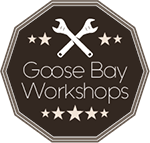There has been a trend in the hobby of re-enacting toward portraying “trekkers’. While we know there were many reasons a man (or woman) of the 18th century might find themselves on extended excursions through uncharted forests; such as exploration, scouting, escape from Indians or avoidance of any number of authority figures who have reason to bring one to account, we can find no evidence that any special cookware or equipment was available to make the journey any easier for these people!
We have documentation that a few wealthy military types owned pots specially created to be light and easy to pack, with removable handles and such see page for our set of pots styled after Washington ‘s). These were extremely uncommon, and it would be pretty remote that the average person, especially on the frontier, would have been able to acquire such specialized equipment! We can not help but conclude that what was brought in to the wilderness was whatever could be sacrificed from the hearth!
Our modern camping trip involves all types of ultra light, rip stop, folding, specialized equipment designed to make our excursions out of doors as comfortable as our own living rooms. Not only was this not available in the 18th century, but we also must remember that their level of comfort was so much different than ours. They were a hardy lot!
We have often imagined a husband on the edge of the frontier about to depart for a few days of hunting. It is very likely that he would not be interested in cooking on such a brief excursion. His wife may have packed some dried meat, bread, cheese and maybe an apple or two. To a person living then, food was food.
There was often little distinction between “breakfast” food and “supper” food. He would not have bothered with beverages other than stream water collected in his horn water bottle. If he cooked, it was only to roast a small rabbit or fish. If he was inclined to gourmet cooking, he would inquire of his wife which kettle she could spare. She would survey her small collection of copper, brass and iron pots. She would choose great grandmother’s old brass kettle. She would caution him to return with it intact as a replacement would cost dearly. And so the hunter leaves in search of game, an old kettle swinging from his arm, his musket dragging behind him!
BARBER’S & SURGEON’S BOWL
HANDMADE BY PETER GOEBEL

Historic reproduction. This is a careful reproduction of Ca. 17th – 8th century barbers and surgeons bowl. A physician would use this bowl for bleeding his patients. Barbers would use it for shaving customers, and perhaps pulling teeth or bleeding. (There was some times little distinction between physician, barber and dentist!) Very heavy gauge brass with a large rim. Ring for hanging.
Dated: 17th & 18th century
Origin: English/other
Materials: brass
Dimensions: 9″dia.
X-0172-B BARBER’S & SURGEON’S BOWL(commissioned work) $59.00
BUTTON POLISHER
HANDMADE BY PETER GOEBEL

Historic reproduction. This button polisher was copied from an 18th century original. They were very common from the 18th through the 19th centuries. Made of heavy brass. Now you can polish those buttons without “mussing up” your expensive coat!
Dated: 18th – 19th centuries
Origin: English
Materials: brass
Dimensions: 12″ long
X-0174-B BUTTON POLISHER(commissioned work) $22.50
MIRROR
HANDMADE BY PETER GOEBEL

Historically inspired. We have no documentation for this mirror, but mirrors similar to this were traded in N. America from very early on. The Native Americans often wore them around their necks, very often on their backs to ward off evil spirits! Ours has a brass frame with a hole for hanging. Even if you don’t wear it- it is handy to have around!
Dated: 16th – 18th century style
Origin: English for trade in N. America
Dimensions: 3″ x 5 1/4″
X-0175-B MIRROR (commissioned work) $19.00
POWDER FLASK
HANDMADE BY PETER GOEBEL

Historic reproduction. This is a museum quality reproduction of a 17th century original. It is a very handsome and unusual piece. Entirely handmade in heavy copper. It has a friction fit lid with a ring for a keeper chain. The lid may be used as a powder measure. Three lugs on each side for a cord. This is a very nice alternative to a horn.
Dated: 17th century
Origin: French
Materials: copper
Dimensions: 4″wide x 5 1/2″tall. 2″ spout, 8″ tall overall.
X-0177-C POWDER FLASK (commissioned work) $105.00
LEAD LADLE
MADE BY PETER GOEBEL

Historic reproduction. This ladle is reproduced from an 18th century original. It is completely hand hammered to form the bowl, and the socket is brazed onto the bowl so it will never “unsolder – unless heated above 1300 degrees (not likely!). The socket is square to prevent rotation of the ladle on the stick (you supply the stick). Two spouts so you can pour from either hand. Go ahead and melt that lead!
Dated: 18th century
Origin: English
Materials: copper
Dimensions: 2 5/8″dia. bowl, 5 3/4″long
X-0178-C LEAD LADLE (commissioned work) $48.00
DUTCH TOBACCO BOX
HANDMADE BY PETER GOEBEL

Historic reproduction. These nifty little boxes are from 17th and 18th century originals. They were originally used for tobacco (hence the name), but we suggest you kick the habit and use them for other purposes! Fill them with small sewing items, candy, etc. These are very attractive boxes, the bottom being copper and the lid being brass! The friction fit domed lids are perfect for engraving! Tin lined. These would make very thoughtful gifts.
Dated: 17th – 18th centuries
Origin: Dutch
Materials: copper, brass, tin
Dimensions: approx. 3″ x 2″ x 1″deep
X-0180-CB DUTCH TOBACCO BOX-OVAL(commissioned work) $47.00
X-0181-CD DUTCH TOBACCO BOX-OBLONG (commissioned work) $47.00
X-0182-CB DUTCH TOBACCO BOX-COFFIN (commissioned work) $47.00
